700 Glengarried Men
1st Battalion Argyll and Sutherland Highlanders Tour of Aden

In January 1967 Lt-Col. Colin Mitchell took over command of the 1st Battalion Argyll and Sutherland Highlanders at Seaton Barracks outside Plymouth. Mitchell had been commissioned into the Argylls at the age of 18 and served with the 8th Argylls where he saw action with them during the final stages of the Italian Campaign during W.W.II. After the war Mitchell decided to make his career in the army and served with the Battalion during it's many post war campaigns including Palestine, were he was wounded, Korea, Cyprus and Borneo. At the time Mitchell took over the Battalion, he considered the Argylls to be one of the most experienced battalions in the British Army. Not only had many of the officers and NCOs fought in different post war campaigns but also most of the Battalion had recently returned from Borneo. The Argylls had been the only British infantry battalion to complete three operational tours, of six months each, in Borneo. And now they were going to be sent to troubled Aden. Mitchell immediately began an intensive training program aimed at getting the Battalion fit and adjusted to working to his methods, which were somewhat different to other COs.
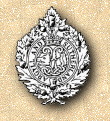
At the beginning of February Mitchell issued a policy directive to "trim the ship" as he put it. It began by stating briefly the cornerstones of his personal philosophy of command. Firstly, that everyone can and should enjoy soldering; secondly, that the Battalion was a band of brothers and not a flock of sheep; thirdly, that leadership is a way of life twenty-four hours a day and seven days a week; fourthly, that physical fitness was paramount; and fifthly, that every member of the Battalion must know and understand his own job and do it one hundred per cent to the satisfaction of himself and others. This was Mitchell's aim to have an efficient and happy fighting Battalion with a reputation of being one hundred per cent professional. Mitchell's reason for issuing this policy directive was to save himself and others hours of time briefing incoming officers and NCOs and by using the directive, members of the Battalion could solve their own problems. Mitchell also made himself accessible at all times to cut down on the chain of command and allowing all the members of the Battalion to deal directly with him; 'Give me a quick verbal briefing and I shall give you a decision there and then'.
Mitchell made the Battalion train around the clock in preparation for Aden. Taking a tip from Rommel, who had trained the Afrika Korps in the Botanical Gardens in Berlin before leaving for North Africa, Mitchell had the barracks gym turned into a steam heated hot-house to try and acclimatize the men to the heat they would have to work in when they reached Aden. QMS Wearne of the Army Physical Training Corps made all the Battalion sweat buckets in this torture chamber, but it did go some way to getting the men used to working in the heat. The Army training areas situated near Dartmoor were also regularly used by the Battalion before the deployment to Aden.
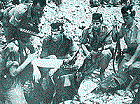
Mitchell realized that the Battalion was now a veteran of jungle warfare after its various tours of Borneo but the only jungle in Aden would be the concert jungle of Crater. To over come this problem Mitchell set up a series of exercises in the Crownhill area of Plymouth near the barracks. The married quarters and other parts of the area converted into a near a facsimile of Crater as the Battalion could make it. Mitchell even went so far as to rename the streets and buildings of this training area to their equivalent in Crater. This was done so the Jocks would instinctively turn in the right direction when told to head for a certain landmark in Crater. The NAAFI was turned into the Aidrus Mosque. For 48 hours at a time Mitchell would turn the Crownwell into Crater. Roadblocks would be set up and soldiers checked and searched. The Quartermaster might be grenaded as he left his office, other troops would come under sniper fire, and cordon and search operations were mounted. Mitchell even inserted make believe journalists and UN observers to investigate charges of brutality by the British troops. All this realistic training was to pay big dividends later in Aden.
Basic Arabic lessons were given to all members of the Battalion as well as classes on Arab manners and etiquette. Each Jock was taught how to say various things in Arabic such as; ' halt or I fire!' ' Hands up ' 'We're going to search you ' and ' Come with me to the police station '. The Jocks were also taught less aggressive exchanges like; ' how are you? ' ' Well, praise God. ' 'You are always well, praise God! '.
By May Mitchell felt that the Battalion was as prepared as they could be, given the time allowed, and were ready for Aden. Morale in the Battalion was excellent. The men affectionately called him Col. Mitch, while the press would later dub him " Mad Mitch of Aden " He had already sent out the Battalion Adjutant and Intelligence Officer D. P. Thomson and some other officers to Aden to draw up the Battalion's own intelligence report of the situation in Crater. D. .P Thomson had been born in Australia and had grown up in the Far East. He had joined the Battalion from Sandhurst in 1963. Thomson had served with the Battalion in Borneo where he had won the Military Cross as a platoon commander. His Arabic was almost fluent. Mitchell and his advance party of 26 officers and men left Gatwick on the 7th of June and flew out to Aden. The Argylls advance party was larger than usual and included all the company and platoon commanders. Mitchell wanted all his officers to spend time with their counter parts in the Northumberland Fusiliers from whom the Argylls were to be taking over.
On arrival in Aden, the Argylls were billeted in the Northumberland Fusiliers barracks, named Waterloo Lines, near RAF Khormaksar. The advance party soon settled in and started working with their opposite numbers in the Fusiliers, learning and gaining important information and experience of the Crater from the Fusiliers. The Northumberland Fusiliers had been highly successful in putting down civil disturbances during their 9-month tour in Crater. Mitchell worked closely with the Fusiliers CO Lt. Col. Blenkinsop.
Around lunch time on the 20th of June Mitchell was walking towards the officers mess at Waterloo Lines when Major Bryan Malcolm, who commanded the Argylls D company, approached him saying "Sir, something's happened and the Fusiliers are going out. I'd better go too. "Mitchell gave his approval and Major Malcolm left with a Fusilier patrol accompanied by two other Argylls, Pte. "Pocus" Hunter and Johnny Moores. A short time later Lieutenant Baty approached Mitchell and also asked permission to accompany the Fusiliers. Baty had fought with the Battalion in Borneo as a sergeant, won the Military Medal there and had been commissioned in the field. Mitchell refused to let Baty go and probably saved the young officer's life. Major Malcolm, his two Jocks and five Fusiliers were ambushed and murdered by the Arab Police in Crater. The full story of this ambush is covered in The Arab Police Mutiny.
Mitchell was furious that the treacherous Aden Police should get away with this crime and made his thoughts known to the press. This would be the start of a long relationship that Mitchell was to have with the press, who made him a national hero and gave him the now well-known name "Mad Mitch". Mitchell encouraged the press to accompany him wherever he went, not to make a name for himself but to throw the limelight on his beloved regiment, which was due to be disbanded due to defence cuts.
On June the 23rd the 1st Battalion Argyll and Sutherland Highlanders arrived in Aden. What happened next has passed into the Regimental history books and cannot be covered in its entirety on this page. Therefore, please read " Operation Stirling Castle " to read all about the Argylls retaking the Crater

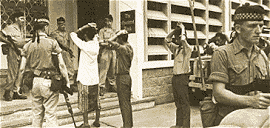
After re-establishing British rule in Crater, the Argylls settled into the job they had come to Aden for. Mitchell set up Battalion HQ in the Chartered Bank, renaming the building Stirling Castle, the regimental home of the Argylls. All the main entrances to the bank were sealed off leaving only a single side entrance for entry and exit. The manager's office became the Regimental Medical Aid Post while other parts of the building were turned into the Jocks dining room and an interrogation centre. The Rolex Watch Company offices on the first floor were turned into the Battalion operations room, the nerve centre of operations in Crater. All the Rolex watches were still there when the Battalion left 5 months later. The second and third floors were turned into accommodation for the officers and men. The top floor had two penthouse flats that were turned into an officer's mess and a sergeant's mess. On the roof Mitchell placed two lookout posts that gave the Battalion a good view of most of Crater. The Pipes and Drums usually manned these positions.

Mitchell divided Crater into three areas. Each rifle company was given responsibility for security in one of these areas. A Company covered the northern part of Crater including the roadblock at Main Pass, which was one of the main entries into Crater. B Company had the coastal area and Marine Drive roadblock. D Company was given control of the centre of Crater where the population was the densest and the streets the narrowest. The reconnaissance platoon occupied observation posts on the Temple Cliffs, the old fortifications on Mansuri and the Browns House Peninsular. The Pipes and Drums remained as the HQ defence force. The Battalions Military Band, which wasa Silver Band as opposed to the Pipes and Drums, had the misfortune of having their newly ordered set of instruments stuck on the far side of the Suez Canal because of the Arab-Israeli war. Without their instruments the bandsmen were more than happy to join in and made an outstanding contribution to the Battalion's manning of roadblocks and other countless tasks.
The Argylls established about 30 different fortified posts throughout Crater. The tops of tall buildings were fortified with concrete and sandbags. All the machine gun positions covered the main streets with interlocking fire. All patrols, posts and vehicles were linked by radio to the Battalion net. Every member of the Battalion, not just the signallers, became used to using the radio to report incidents. This brought a heavy workload on the Battalion's signals officer Hugh Clark. The Argylls aggressively patrolled their areas of responsibility, some times accompanied by armoured cars of the Queen's Dragoon Guards and later the Queens Own Hussars. Foot patrols were carried out at night because of the terrorists' fear of the dark. At first all streetlights were turned off but after a few days orders came from the civil authorities that the lights must be switched on again. This meant that the foot patrols were now vulnerable to sniper fire. This situation was dealt with by the Jocks taking the street lights out! There was no official curfew in Crater but Mitchell informed the Arab Police to tell the inhabitants of Crater that they would be safer if they kept off the streets after 7pm. Some Arab cars would try and blind the Argyll patrols at night with their headlights so the Argylls enforced a new rule of "side lights only". This some times cause confrontations which were decided by Argylls rifle butts coming into swift contact with the offending cars head lights.

Mitchell wanted to let the terrorists know that "there was a new sheriff in town" The Jocks were told to go in hard and make sure they made their presence felt. Mitchell went so far as to reprimand one of his junior officers using a doorway for cover during foot patrol saying to him, "What the hell are you doing? Get out into the middle of the street and let the people see you!" It wasn't just the foot patrols that were ordered to make their presence felt. All the Argylls Land Rovers had their roofs and sides removed and heavy machine guns mounted making the vehicles look like they were "looking for trouble". Mitchell ordered that all troops from now on would wear the Argyll Regimental Cap Badge in their Glengarries. Up until then the Argylls were forced to wear the 'Highland Brigade Badge" which was a stags head on a St. Andrew's cross. The Jocks called this badge 'The Crucified Moose'.

Mitchell was determined to keep the terrorists guessing and he constantly changed orders so there was nothing routine about the Battalion's movements around Crater. One day he would order that all Arabs riding motorcycles were to be stopped and searched; the next day he would order all taxis to be stopped. It had always been thought that the terrorists were using the taxi drivers as a source of information, so the Argylls started to curb the speeding and honking horns of the taxis. They became very successful at doing this and the taxi drivers soon realized that speeding and the honking of horns was taboo from now on. The Argylls also changed the traffic rules and made a one-way circuit for all civilian vehicles allowing the Argylls vehicles to drive whichever way they cared to take. A bit like the freedom of the road a fire engine has in Britain.
Mitchell also put together a 'Phantom' observation patrol that would secretly occupy a flat in the Crater during the hours of darkness. In the morning, taking care not to been seen, the 'Phantom Patrol' would observe and report back to Battalion HQ without the terrorists knowing where they were.
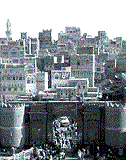
On the 5th of July orders came down from above that the main entrances to Crater, Main Pass and Marine Drive were to be opened up again. Mitchell had had these entrances sealed since the Argylls had re-entered Crater. The Jocks could still search all civilian vehicles but they were forbidden from searching any vehicle belonging to the Aden Police, the Armed Police or the South Arabian Army. This made it easy for the terrorists to smuggle weapons into Crater.
Mitchell was determined that there would not be a repetition of the murders of the 20th of June and promised his men that no Argyll would ever be left to die in Crater. He informed all his officers and RSM McKernen that if the situation ever occurred they were to counter attack without waiting for permission from himself. It was an order sent all the way down the line. ' If you have no ammunition you are to go in with the bayonet. It's better that the whole Battalion dies in Crater to rescue one Jock then that any one of us come out alive'.
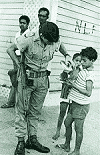
The occupants of Crater started to realize that there was a new boss in town. Mitchell arranged for a rumour to be spread saying that the Argylls were wild Bedouin tribesmen from the far off hills of Scotland who would get very rough if provoked. The Argylls on patrol encouraged this rumour. All the Argyll officers wore blue shirts, a tradition dating back to pre-war service in India. Because of the blue shirts, one local rumour that was spread by Arabs in the local bazaar was that the Argylls were in fact a Jewish penal battalion and the ones in the blue shirts were the Rabbis! On the 13th of July Mitchell was told that the Battalion was to attend a ceremonial parade at the Arab Armed Police Barracks. The higher authorities felt it would be good to help rebuild the status of the ex-mutineer s, the Arab Armed Police, who were responsible for the 20th of June murders. General Tower was to take the salute. This parade left a bad taste in every Argyll mouth. Mitchell ordered that kilts should be worn at the parade with orders to shootanything not wearing a kilt if they stepped out of line.
After a few days the Arab population realized that there was not going to be a revenge massacre for the 20th of June and a sense of normality started to return to Crater. The tough line adopted by the Battalion started to earn the respect of some of the Arab inhabitants who had seen too much violence over the past few years. Many had left Crater after the 20th of June attack. With the re-opening of Main Pass and Marine Drive, many residents started to return to Crater. Shops started to re-open and resume business. Mitchell let it be known that 'Argyll Law ' was now in place. His Jocks would keep the peace, if there were no more acts of terrorism committed on his watch. If troubled started, however, he would give the order 'Portcullis'
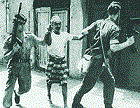
'Portcullis' was the code name give by Mitchell to his order for Crater to be sealed and the stopping of all traffic and movement inside Crater. Any Arab male between the ages of 15 and 35, who was found anywhere near where an incident had occurred would be arrested and held until interrogated. Mitchell used the word 'Portcullis' because it implied strength and security. All suspects were taken separately into Battalion HQ where Nigel Crowe, Mitchell's Arabic speaking officer, and his team of interrogators, interrogated them. Each Arab was also photographed and finger printed. By doing this, the Argylls started to build a large database of the big and small 'players'. To some this was seen as being very heavy-handed treatment.
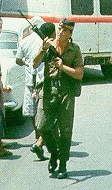
The order of 'Portcullis' first went out on the 15th of June after a terrorist grenade was thrown at Lieutenant Jamie Graham's platoon. Graham's father Freddy Graham had commanded the 1st Battalion in Italy during W.W.II and later became Colonel of the Regiment. Corporal Aucherlonie and three privates were wounded in the attack. On hearing the report of the attack Mitchell did not hesitate and gave the order 'Portcullis'. Crater was sealed and suspects rounded up but the grenade thrower was never found. After this operation complaints started to pour into the High Commission about the rough behaviour of the Argylls. This was the start of a smear campaign against Mitchell and his Argylls. The Egyptian Intelligence Service organised some of the smear campaign but the Argylls also had their critics within the British High Commission. One member of the High Commission even refereed to the Argylls as 'Those Glasgow thugs' He later had the good sense to apologise after Mitchell informed him that his mother had come from Glasgow.
On the 18th of July Mitchell was ordered to report to the GOC in Aden, Major-General Philip Tower, who did not approve of Col. Mitchell's use of the press. At the meeting Mitchell was informed by General Tower to "throttle back "; in other words Mitchell was not allowed to order " Portcullis" again and from now on all searches and interrogation had to made with the Arab Police present. This came, as a shock to Mitchell who realized that operating in Crater would be extremely difficult under these circumstances. The terrorists would once again gain the upper hand. He therefore sent out these written orders to all ranks:
Action in Crater
- The methods we have used to dominate and pacify Crater have brought a flood of complaints from local nationals and the Federal Government authorities. We have been accused of stealing, brutality, wilful damage and arrogance. This is the "Smear" campaign I warned you to expect. It was bound to come whatever we did and some of it was bound to stick. The fact remains that for two weeks we have preserved the peace in Crater with only three incidents at a cost of four of our own men wounded, one Arab killed and anotherwounded, firing from the Aidrus Mosque
- I want all ranks to know how much I personally admire the way the Battalion has operated since arriving in Aden. I believe that our techniques and methods have paid off. If the day arises when we can use them again I know that they are the answer to the problem. 1 A and SH is justly famous for it's tough line and I know that you have all been terrific. Welldone!
- However, I have now been ordered to "throttle back" in the interests of a political settlement. The civil population has squeaked and I am reluctantly forced to modify or abandon some of our techniques. I am well aware of the disappointment this will cause to all of you but I too am a soldier under orders and must be 100 per cent loyal to my own superiors just as you to me
- Life will become a bit more dangerous now that we are prohibited from dominating the situation our own way. In the Argylls we thrive on danger so let us be even more alert - with fingers on the trigger for the good kill of a terrorist, which may soon present itself
- Company commanders are to ensure that this order is brought to the attention of ALL ranks in the Battalion by repeating it in Coy Details.
Up the Argylls
Mitchell sent a copy of this order to General Tower to show that he was carrying out the General's orders. Unfortunately Tower never read it and only heard about it a few days later. Mitchell was summoned once again to GHQ and severely "dragged over the coals".
The Argylls "throttled back" as ordered and the mood in Crater changed. The Arab Police became less intimidated by the presence of the British troops. The Arab terrorists also felt that they could now re-start the bombing campaign. On the 18th of July an Arab terrorist was shot and killed by an Argylls patrol close to where Corporal Aucherlonie's party had been attacked on the 15th.
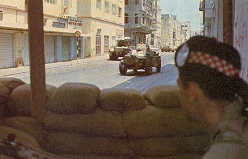
On the afternoon of the 21st of July the first Argyll, since the 20th of June murders was killed. Lance Corporal Willie Orr was inspecting the observation post above the market place. Suddenly from the crowded tangle of buildings, less than two hundred yards away, came two bursts of automatic fire. The shots, probably fired from the back of a room to hide the muzzle flash, caught LCpl Orr where his body was exposed over the parapet and killed him instantly. The Argylls immediately surrounded the building where the shots had come from and started to search for the sniper and his weapon. Neither was found. One Arab tried to break out of the cordon around the building and was shot dead after failing to halt when challenged. LCpl Orr had served in Mitchell's company in Cyprus and had only been promoted from Private two days before his death.
On the evening of the 22nd a patrol from D Company moving down an alley off Zafaran Road stopped to question an Arab who was acting suspiciously. The Arab panicked ad tried to grab one of the Argylls rifles. Both men fell to the floor in the struggle. The Argyll, knowing that he could not shoot the Arab in such a confined place with out the possibility of hitting one of the patrol as well, took the only other option he had and killed the Arab with his bayonet.This incident was seen as an un-called for use of brutality by the higher authorities and new orders were delivered to the Battalion saying that bayonets were no longer allowed to be taken on patrols! The Argylls felt as though their hands were being tied behind their backs.
The terrorist attacks started to increase. The next night a patrol from Major Robertson's company shot a terrorist armed with a Czechoslovakian automatic pistol. That same night small arms fire was directed at an Argyll post on the Treasury building with out causing any casualties. The next morning a Russian grenade was thrown at an Argyll mobile patrol. It failed to explode. On the 26th a sniper tried to pick off anther Argyll on a roof top post on the Gazeira Palace Hotel. Fortunately the bullet passed through the Jock's shoulder.

Grenades were now being thrown at the Argylls on a regular basis. The terrorists would use the local Mosques to hide before and after they threw their grenades. British soldiers were forbidden from entering the Mosques in Aden. If they suspected that a terrorist was in a Mosque they would have to call in the Arab Armed Police to search the building. This was a pointless exercise because the Police rarely bothered to turn up or would arrive two hours after the incident and find nothing. To over come the problem of the Mosques, Mitchell came up with a new technique.On the night of the 23rd Argyll snipers secretly placed themselves in positions over looking the entrances to the Mosques. By doing this Mitchell had to reduce the amount of men on the roof top option. Life-size dolls took their place, "dummy Jocks", complete with Glengarries. This charade fooled the terrorists who would take the time to know where most of the Battalion was before they would attack.
At 9.49 the next morning the first terrorist grenade of the day was thrown at a platoon HQ, casing no casualties. At 9.58 anther grenade was throw at the Argylls cordon. At 9.59 two shots rang out and two Arab terrorist lay dead. Shot by the Argyll snipers as they ran back into the Mosques. By the end of the day, after more grenades had been thrown, three Arabs had been killed and one Argyll wounded and the terrorists knew that the Mosques were no longer the safest place to hide.
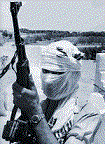
British Intelligence suggested that the terrorists planned to bring in some "hard core specialists " and the Argylls could expect some major attacks on their patrols and posts on the 1st of August. Mitchell was told " The Argylls are in for it" to which he replied 'Excellent, that is exactly what we want, bring 'em out in the open". On the morning of the 1st the terrorists stated their new campaign. Three mortar bombs fell on and around the Chartered Bank (Battalion HQ). A patrol later found the location of where the mortar had been fired by the marks the base plate had lefton the ground. Four days later Mitchell was entertaining a few visiting officers from other units in the mess at the Charted Bank. They had just finished their meal when the whole building shook under the impact of several explosions. Mitchell ran to the top of the roof to find the sentry Piper Oakley badly wounded but still at his post. Just behind him lay the body of the Pipe Corporal Jimmy Scott. Both had been on roof top duty when the mortar attack began. Shrapnel from the first bomb had wounded Oakley. Cpl. Scott had rushed to his aid but had been hit full on by the second mortar round, killing him instantly. Although badly wounded Oakley stayed at his post and continued to observe the flight of the mortar bombs and describe to Mitchell where he thought they were coming from. Mitchell took a fix on the probable position of the mortar and sent a mobile patrol to try and find it. But they were unsuccessful. The mortar was discovered two days later during a search of the Public Works Department vehicle yard. It turned out to be a standard British 2 inch mortar that had earlier been supplied to the South Arabian Army up country. It had probably been smuggled into Crater in an Arab Police vehicle.

After the attack Mitchell set to work strengthening the Chartered Bank with more and more sand bags. So many sandbags were used that the Jocks started to call the building 'the Sand Bank." Every available hand back atWaterloo Lines was put to work filling sandbags, including some unfortunate RAF personnel who were "press ganged ' while in the NAAFI, but they were only to glad to help the Jocks. It was not just the RAF who helped out the Jocks, Men from the Royal Corps of Transport carried jerry cans full of iced drinks up to the Jocks on duty on the steep hill around Crater before the re-entry had taken place. They were not ordered to, they were not asked to, and they just did it. Sappers of 2 Troop 60 Squadron Royal Engineers worked closely along side the Argylls helping to improve the Jocks' positions, fix plumbing, mend elevators and solved many other problems that came along. Mitchell later said " In Aden the infantry for once stole the glory but this should never be allowed to obscure the part played by all the other arms and corps and, of course, the other two services."
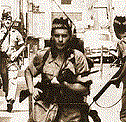
Grenade, mortar and rocket attacks directed at the Argylls continued throughout August. On the 3rd August two 94 grenades electrically fired from spigots, exploded next to Mitchell's Land Rover. On the 4th five mortar bombs landed near Major Robertson's company HQ. RSM McKernen had a close shave, when as he was dismantling a battery of primed spigot grenades, a grenade was thrown at him. It landed in his Land Rover setting fire to the vehicle. While on patrol on the 7th Private Dickson of B Company was just about to send in a report on his manpack wireless set when he saw a terrorist throw a grenade at the patrol. Dickson shouted a warning to the rest of the patrol and they all took cover. The grenade went off between Dickson and patrol commander wounding both of them. Dickson calmly radioed in a report of the attack and requested evacuation for the patrol commander. Other members ofthe patrol did not realize Dickson was wounded until they had returned to base and he told them he wasn't feeling too good. On examination they discovered that he'd been hit by flying shrapnel in the legs and arms and was rushed off to hospital.
Mitchell also came under some personal attention from the terrorists when the Chartered Bank came under sniper fire. Mitchell was not in the building at the time but when he returned he found bullet holes on the wall above his bed in the officers' mess. The Royal Engineers replaced the windows in Mitchell's room with steel shutters. Mitchell said, "I felt like I was a submariner".
By the end of august the Argylls had suffered five killed and eighteen wounded. They had killed twenty terrorists and wounded five. On the other hand the terrorists had killed 27 civilians and wounded many more through their indiscriminate bombing campaign.
Then all of a sudden the terrorist attacks stopped. From the beginning of September to the middle of October there was not a single terrorist incident in Crater. Mitchell believed that "our finds of ammunition and explosives finally took the wind out of their sails". The un- official cease-fire was short lived.

On the 14th of October the terrorist mortar team came back into action firing on various targets around Crater. One Argyll patrol had a narrow escape when a parked car exploded as they were approaching it. On the morning of the 20th a grenade was thrown at an Argyll foot patrol wounding one Argyll and two Arab bystanders. The Argylls chased the two terrorists who had carried out the attack. They shot both of them. One was killed and the other although wounded, managed to escape. He tried to leave Crater in a taxi, which was stopped at an A Company roadblock. The taxi driver tried to run though the roadblock and was shot dead along with the wounded terrorist. Next day Mitchell was visiting the police station when he and his escort saw a grenade being thrown at Major Ian Mackay's (D company) Land Rover as it turned the corner from Market Place. One of the Argylls in the Land Rover was blown out of the vehicle. Major Mackay leapt out of the burning vehicle and with his pistol drawn started to chase the terrorist. Mitchell and his driver Cpl Mitchell saw another terrorist running towards the meat market and chased after him followed by D. P. Thomson. Inside the market Mitchell told them to split up and look for the terrorist who was wearing a bright "futah" All of a sudden Mitchell found himself quite alone among hundreds of Arabs. Not a good situation to find yourself in. Luckily D. P. Thomson, armed with an SLR, bumped into Mitchell and they both left the market ASAP. D Company had cordoned off the area and Major Mackay's men had shot the first terrorist. The second terrorist was also flushed out and shot. He had a Russian RG4 grenade hidden in his futah. In the last few days' things had not gone to well for the terrorists. Six had been shot dead, one arrested, two wounded and two escaped.
The beginning of November began with NLF and FLOSY stating to "Duke it out " to see who was going to take over once the British had left. Groups of Arab gunmen took to the streets of Little Aden and Sheikh Othman. There were many murders and kidnappings. Over a period of two days over 50 bodies were discovered on the streets. But not in Crater, which still flew the Union and Argyll flags. The terrorists were killing each other rather than taking on the Argylls. In fact Crater was a fairly safe place to be and many Arabs entered Crater to seek shelter from the killings. One group of Arabs in the market even disarmed a grenade carrying terrorist by them selves before the Argylls arrived On the 5th of November an explosion was reported in Crater and an Argyll patrol reported a taxi speeding away from the blast. The same taxi was later seen by another patrol trying to drive up a one-way street against on coming traffic. The Argylls challenged the occupants of the taxi, who then tried to make a run for it. The driver escaped but two others were killed, while one was found to be carrying a .38 pistol.

On the 6th some of Mitchell's company commanders told him that they felt some thing was about to happen in Crater. Mitchell decided to have a look around the town for himself. About 11.30pm Mitchell and his escort were driving past the long wall of the Armed Police Barracks when a grenade came sailing over the wall and landed behind them. Shrapnel from the explosion wounded Brian Baty and two Jocks in the rear of the vehicle. Mitchell was furious. He parked his Land Rover and radioed for D Company to come down and surround the Barracks. With D. P. Thomson and Brian Baty, Mitchell walked up to the Barracks main gate in full view of the Arab sentries positioned in the guard towers and demanded to let in. By now D company had arrived as well as a section from A company with anarmoured car. Mitchell was let in to find most of the Arab Police, in various stages of un-dress, drawing weapons from their armoury. Mitchell demanded to see the Arab Superintendent Ali Gabir. Gabir soon arrived with a worried look on his face. Mitchell told him what had happened and showed him where the grenade had been thrown from. Gabir expressed his horror and surprise at what had happened. Mitchell addressed the Arab Police telling them they had had a narrow escape. If it had not been for the discipline of his men there would have been a lot of blood shed that night. After expressing some more of his feelings Mitchell left.
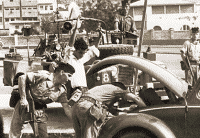
Next day one of the biggest incidents of the Argylls tour of Aden took place, when an Argylls foot patrol observed a car suspiciously driving around packed with lots of young Arabs. The vehicle was ordered to stop and when it did all the occupants, four carrying guns, leapt out and opened fire on the patrol. A huge firefight then ensued between the terrorists and the Jocks. The Jocks being the superior players in the shoot out killed all four gunmen before they could do any damage. When the shooting had died down it was discovered that one of the Arabs in the car was a Shell Oil Company employee who had just been kidnapped and was being driven off somewhere to be executed by the terrorists. More mortar bombs were fired at Argyll positions during the day causing no harm to Jocks but badly wounding several Arab children.
 H.M.S. Albion
H.M.S. AlbionPreparations for the withdrawal from Crater and the whole of Aden were well underway by mid November. The Battalion Quartermaster Ron Smith had returned all non-essentials and the Battalion was now living a rather Spartan life. All British Army positions were to be handed over to the South Arabian Army. Senior officers from the South Arabian Army toured the Battalion's positions on the pretext that they wanted to see what they would be dealing with. But the Arab officers only seemed interested in making sure that certain items were left behind, such as refrigerators, air-conditioners, carpets and other items of "loot".
The dates of the withdrawal were to be the 25/26 of November " W" day. 42 Commando would withdraw from Tawahi. 45 Commando would withdraw from Ma'alla and the Argylls from Crater. The Argylls would fly out from RAF Khormaksar, followed by 1 Para who were holding the northern end of the Khormaksar plain. 42 and 45 Commando would take up positions in the South and on the lip around Crater. As soon as the Paras and Argylls had flown out, 45 Commando would follow them by air. 42 Commando would be the last to leave. The Marines would be choppered out to H.M.S. Albion lying offshore.

Operation "Highland Clearance" was the codename Mitchell gave to the Argylls withdrawal from Crater. In the early hours of November the 26th the Argyll & Sutherland Highlanders lowered their regimental colours in Crater while the regimental piper played "The Barren Rocks of Aden". The Battalion did not expect too much trouble from the terrorists, as they were too busy fighting amongst themselves. On the appointed hour Mitchell ordered his company commanders to start withdrawing. Argyll & Sutherland Highlanders lowered their regimental colours in Crater while the regimental piper played "The Barren Rocks of Aden". Many TV and news crews arrived to witness the event. Mitchell placed himself out side the Chartered Bank HQ to make sure all the Jocks passed through safely. After all had passed though, apart from a small patrol from B Company, Mitchell and D. P. Thomson took a quick tour of the town before returning to the Chartered Bank and handing over the set of keys for the building to the officers of the South Arabian Army.
Mitchell then sent a message by radio over the Brigade Radio Net saying that there were no longer any British troops left in Aden, ending the message with the words, "Up the Argylls". Mitchell and his party then left Crater followed by the patrol from B Company. Mitchell had given the "Last to Leave" honour to B Company because they had been the first to enter Crater.
Through out the last few months you could not open a newspaper in Britain without reading something about "Mad Mitch" or the Argylls in Aden. They were the talk of Britain. To many of the other British army regiments serving in Aden at the time it seemed a little unfair that the Argylls were getting all the glory. But Col. Mitchell had good reason for working hard to promote his regiment- because the Argylls were due to be disbanded. When the British public later heard of this, millions of them wrote to petition the British Government to save the Regiment, which still serves as part of the British Army today.
 Lt-Col. Colin Mitchell
Lt-Col. Colin MitchellAs for Mitchell, usually a battalion commander would receive a DSO for his excellent control of the situation. Lt. Colonel Mitchell had stepped on too many feet in his efforts to save his regiment and received no recognition what so ever for his part in the re-taking of Crater and was not promoted again. He left the Army in 1968 still only a Lt. Colonel. It was a big personal sacrifice to make to save a regiment. Mitchell left the army soon after returning from Aden. He soon back at the front working as a war corespondent covering the war in Vietnam. He later became a member of parliament. Mitchell has since passed away. The Jocks who served under his command still have a great deal of respect for "Mad Mitch".
During their tour of Aden the Argylls had suffered 5 killed and 25 wounded. More casualties than they had suffered in the past 11 years in Suez, Cyprus and Borneo put together. Since their departure from Aden the Argylls have regularly been accused of dealing out brutality. These accusations have yet to be proven. Most of it can be put down to revolutionary talk coming from Arabs. The British Army has also some times pointed the finger at the Argylls calling them "Arab Eaters".
This name came about after a story was spread saying that a Argylls patrol, which had been stranded in Crater, returned to base a few days later minus their Arab guide. The story goes that the Argylls had eaten their Arab guide!
The song "700 Gengarried Men" was written by a Lieutenant Graham in the period after the Battalion had left Aden, when the Argylls were threatened with disbandment. The song played a major part in the successful " Save the Argylls" campaign. We'd like to say a big thank you to ex Argylls John Aitken AKA "Big Bits", William Morton AKA "Big Mo", Ray Vearnals and Roy Strachan for supplying us with the words to the song. We'd also like to thank Sgt. Eddie Rae, a serving NCO of the 1st Battalion, for bringing the existence of the song to our attention.
700 Glengarried Men
In the heat of the sand houses burnt out of hand
You will see them
In a town once mire ruled by violence and fire
You will see them
Out of the North the law of the Scot
Who decide What is and what is not
(Chorus)
Seven hundred glengarried men
Heard the cry come ringing down the Glen
Dina mind the sand take your rifle in your hand
The Argylls are moving again
Amid sandbags and wire hit by terrorists fire
You will see them
With a bayonet and gun in the streets scorched by the sun
You will see them
From the town of Crater you will hear the cry
You must learn to live in peace or learn to die
(Chorus)
We will not forget our loss five men beneath the cross
You will see them
And although these men may die ours is notto reason why
You will see them
In this fight there is no glory and death comes by the rules
The lives of Highland Soldiers in the hands of English fools
(Chorus)
Tho to Aden goes our song from the Arctic to Hong Kong
You will see them
Amod Jungle Hill or town Againstyello, white or brown
You will see them
For this is but a chapter in our bloody history
Fighting for our future and to keep our country free
(Chorus)



